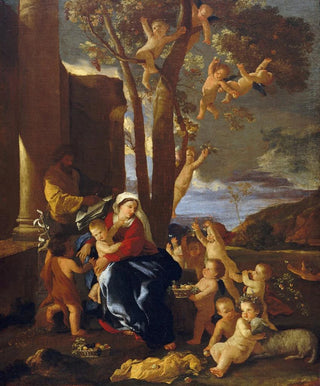Art print | The Holy Family with Saint John the Baptist - Nicolas Poussin


View from behind

Frame (optional)
In the world of Baroque art, few works manage to capture the essence of spirituality and human tenderness like "The Holy Family with Saint John the Baptist" by Nicolas Poussin. This canvas, created in the 17th century, embodies not only the technical mastery of the artist but also his profound understanding of religious and familial themes. Contemplating this piece, the viewer is immediately transported to a world where divinity and humanity meet, creating an atmosphere filled with serenity and devotion. The characters, frozen in a moment of sacred intimacy, invite reflection on faith, motherhood, and the relationship between the divine and the earthly.
Style and uniqueness of the work
Poussin's style is inseparable from his quest for harmony and clarity. In "The Holy Family with Saint John the Baptist," each element is carefully arranged to create a balanced composition. The color palette, subtle and gentle, evokes natural light bathing the figures, emphasizing their humanity while preserving their sacred character. The poses of the characters, imbued with grace, demonstrate an inner dynamism, where Mary's maternal tenderness for the Child Jesus blends with the veneration of young John the Baptist. The depth of exchanged gazes and the delicacy of gestures reveal palpable emotion, making this work not only visually striking but also deeply moving.
The artist and his influence
Nicolas Poussin, an emblematic figure of French classicism, established himself as one of the masters of his time thanks to his ability to combine intellectual rigor with artistic sensitivity. His training in Italy, in contact with the great masters of the Renaissance, shaped his unique approach to painting. Poussin sought to transcend mere realism to reach a philosophical and poetic dimension in his works. His influence has marked not only his contemporaries but has also resonated through the centuries, inspiring generations of artists to explore similar themes, while integrating elements of composition and storytelling that continue to enrich

Matte finish

View from behind

Frame (optional)
In the world of Baroque art, few works manage to capture the essence of spirituality and human tenderness like "The Holy Family with Saint John the Baptist" by Nicolas Poussin. This canvas, created in the 17th century, embodies not only the technical mastery of the artist but also his profound understanding of religious and familial themes. Contemplating this piece, the viewer is immediately transported to a world where divinity and humanity meet, creating an atmosphere filled with serenity and devotion. The characters, frozen in a moment of sacred intimacy, invite reflection on faith, motherhood, and the relationship between the divine and the earthly.
Style and uniqueness of the work
Poussin's style is inseparable from his quest for harmony and clarity. In "The Holy Family with Saint John the Baptist," each element is carefully arranged to create a balanced composition. The color palette, subtle and gentle, evokes natural light bathing the figures, emphasizing their humanity while preserving their sacred character. The poses of the characters, imbued with grace, demonstrate an inner dynamism, where Mary's maternal tenderness for the Child Jesus blends with the veneration of young John the Baptist. The depth of exchanged gazes and the delicacy of gestures reveal palpable emotion, making this work not only visually striking but also deeply moving.
The artist and his influence
Nicolas Poussin, an emblematic figure of French classicism, established himself as one of the masters of his time thanks to his ability to combine intellectual rigor with artistic sensitivity. His training in Italy, in contact with the great masters of the Renaissance, shaped his unique approach to painting. Poussin sought to transcend mere realism to reach a philosophical and poetic dimension in his works. His influence has marked not only his contemporaries but has also resonated through the centuries, inspiring generations of artists to explore similar themes, while integrating elements of composition and storytelling that continue to enrich






